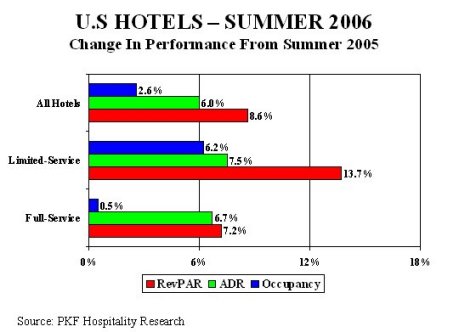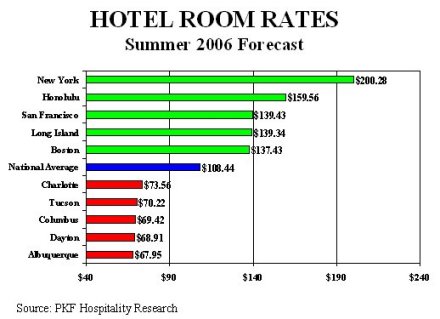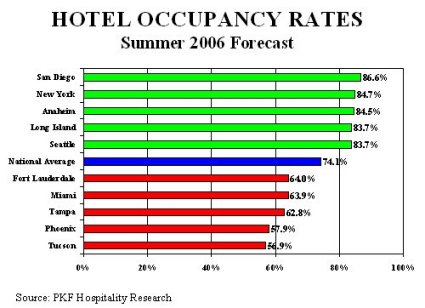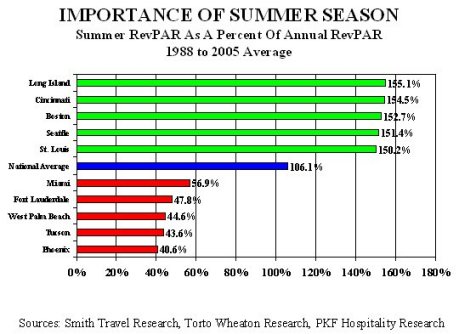advertisement
..
|
|
|
|
| ATLANTA, Ga., June 27, 2006 � Two conclusions from a recent report
issued by PKF Hospitality Research are likely to have an impact on travelers
staying at hotels this summer. First, hotel rooms will be harder
to find, compared to last year, and, second, travelers will pay more for
these rooms. In fact, summer travelers are forecast to spend an average
of 6.0 percent more to rent a hotel room this summer compared to the summer
of 2005. Hotel occupancy rates are forecast to average 74.1 percent,
the highest level since 1997. This analysis is based on the summer
2006 edition of Hotel Outlook, an econometric forecasting model developed
by PKF Hospitality Research (PKF-HR) and Torto Wheaton Research.
�It will be tough to find a hotel room during the summer of 2006 without booking in advance,� said R. Mark Woodworth, president of Atlanta-based PKF-HR. �Given the increasingly sophisticated yield management practices within the hotel industry, the high occupancy rates are enabling managers to more aggressively quote the highest room rates. This is good news for hotel owners, but not for consumers.� News of high gas prices created speculation that people would curtail their summer travel plans. However, historical analyses have shown that the nation�s population will continue to take their summer vacations even during tough economic times. �Regardless of recessions or energy crises, we have observed that the public continues to travel, but they will alter their traditional plans,� Woodworth said. �This summer, in order to compensate for higher gas prices and airfares, we are seeing a migration toward more economical accommodations. The gain in limited-service revenue per available room, or RevPAR, of 13.7 percent is far greater than the 7.2 percent increase forecast for full-service properties.� During the summer of 2006, limited-service occupancy levels are projected to increase 6.2 percent to a level of 74.8 percent. Full-service hotels are forecast to achieve an average occupancy of 73.8 percent, an increase of just 0.5 percent from the summer of 2005. Hotel Outlook is an econometric forecasting model developed jointly by PKF-HR and Torto Wheaton Research. The model is based on historical data from Smith Travel Research and economic inputs from economy.com. Hotel Outlook forecasts provide six-years of supply, demand, occupancy, average daily rate (ADR), and RevPAR information for 52 major markets across the United States. The forecasts are updated each quarter. For Bargains, Head South The summer season is very important for 41 of the 52 markets covered by Hotel Outlook. However, for the remaining 11 markets, occupancy and ADR levels in the summer are less than the annual average. These are the markets where potential discounts may be found. �When looking at the markets with the lowest summer room rates relative to their annual ADR, many of the markets are located in the Sunbelt. For example, the average price paid for a hotel room during the summer in Florida and Arizona is 15 to 30 percent less than the average daily room rate for the year. It is not surprising that occupancy levels in these same markets are roughly 10 to 30 points below the annual level as well,� Woodworth noted. �Visitors who get along well in high temperature climates will enjoy relatively low prices.� Some of the lowest room rates can be found in the places like the Buckeye state, where air temperatures are more moderate. �To truly enjoy a bargain vacation, people may want to visit the Air Force Museum in Dayton or window shop in and around Easton Town Center in Columbus,� Woodworth advised. The lowest average room rate this summer is likely to be found in Albuquerque. �This will make the cost of gasoline driving along the Turquoise Trail a little easier to absorb,� Woodworth said. Crowded On the Coasts Since 2001, some of the greatest swings in lodging performance have occurred in the major coastal cities of the U.S. Hotels in these markets have seen their revenues cut in half during the recession, only to approach all time high occupancy levels in 2005. Part of this extraordinary recovery can be attributed to the return of tourists during the summer season. �New York, Honolulu, and San Francisco hotels are all forecast to achieve occupancy rates in excess of 80 percent during June, July, and August, as well as charge the highest room rates during these months,� Woodworth said. �What is interesting to note is that summertime is a relative bargain in these cities. The average summer room rates in New York, Honolulu, and San Francisco are less than their annual average ADRs.� |

. |

. |
 |
 |
| To order a Hotel Outlook forecast for your market, please visit the
firm�s online store at www.pkfc.com/store,
or call Brandon Culp or Claude Vargo at (866) 842-8754.
PKF Hospitality Research (PKF-HR), headquartered in Atlanta, is the research affiliate of PKF Consulting, a consulting and real estate firm specializing in the hospitality industry. PKF Consulting has offices in New York, Philadelphia, Washington DC, Atlanta, Indianapolis, Houston, Dallas, Los Angeles, and San Francisco. |
| Contact:
R. Mark Woodworth
|
| Also See: | Hotel Management Fees on the Rise, Incentive Clauses Triggered In 2005 / June 2006 |
| U.S. Hotels: Revenues and Profits Rise, But So Do Expenses / 2006 Trends in the Hotel Industry / May 2006 |
.